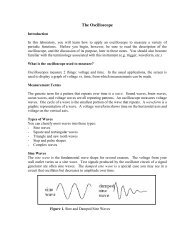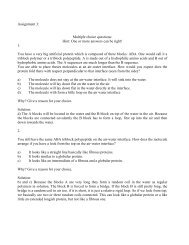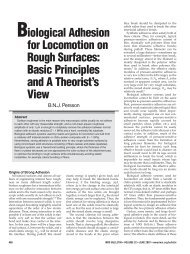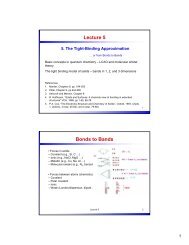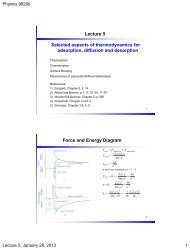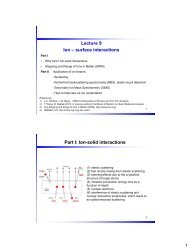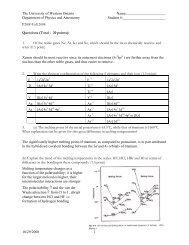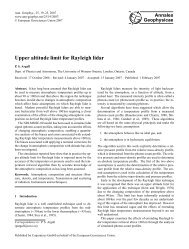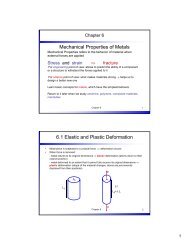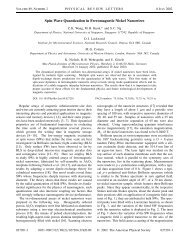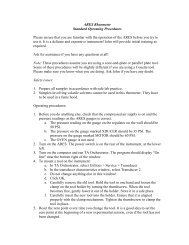Lecture 4 Ultrahigh Vacuum Science and Technology 4.1 Basic ...
Lecture 4 Ultrahigh Vacuum Science and Technology 4.1 Basic ...
Lecture 4 Ultrahigh Vacuum Science and Technology 4.1 Basic ...
Create successful ePaper yourself
Turn your PDF publications into a flip-book with our unique Google optimized e-Paper software.
Physics 9826a<br />
<strong>Lecture</strong> 4<br />
<strong>Ultrahigh</strong> <strong>Vacuum</strong> <strong>Science</strong> <strong>and</strong> <strong>Technology</strong><br />
Why do we need UHV?<br />
1 Atmosphere = 760 torr; 1 torr = 133 Pa; N ~ 2.5 ×1019molecules/cm3 Hertz-Knudsen equation<br />
p<br />
ZW<br />
=<br />
1/<br />
2<br />
( 2πmk<br />
T)<br />
At p = 10 -6 Torr it takes ~ 1 s to one molecule thick layer (1 ML)<br />
So, for reasonable measurement times:<br />
at p = 10 -10 Torr it takes ~ 10 4 s = 2.75 hrs for 1 ML<br />
References:<br />
1) Leybold Product <strong>and</strong> <strong>Vacuum</strong> <strong>Technology</strong> Reference Book<br />
2) Woodruff & Delchar, pp. 4 – 11<br />
3) Luth, pp.6-17<br />
4) Kolasinski, Chapter 2, pp. 57 -61,<br />
5) Yates, Chapter 1<br />
<strong>Lecture</strong> 4 1<br />
<strong>4.1</strong> <strong>Basic</strong> Principles of UHV<br />
Use 3 interrelated concepts to define<br />
vacuum (all related to pressure)<br />
• Molecular Density (average number of<br />
molecules/unit volume)<br />
• Mean Free Path (average distance<br />
between molecular collisions)<br />
• Time to monolayer formation, τ ML<br />
<strong>Lecture</strong> 4 UHV 1<br />
B<br />
<strong>Lecture</strong> 4 2
Physics 9826a<br />
4.2 How to attain UHV?<br />
Function of a pump: Molecules strike or pass through an orifice of<br />
area A <strong>and</strong> enter the pump, which attempts to keep them from<br />
returning to the volume V.<br />
For an ideal gas, using kinetic theory, one can calculate the rate of<br />
pumping <strong>and</strong> p eq : (see Appendix A-I)<br />
From Eq.8 of A-I, for an ideal system (no leaks or outgassing):<br />
dp<br />
dt<br />
= −<br />
S<br />
V<br />
p;<br />
S<br />
- pumping speed (l/s) ;<br />
⎡ S ⎤<br />
p = pi<br />
exp⎢−<br />
t⎥<br />
p = 0 at t = ∞;<br />
⎣ V ⎦<br />
P, V, N<br />
area<br />
A<br />
to<br />
pump<br />
8 kT<br />
ν a AK<br />
s = =<br />
π m<br />
AK;<br />
K − statistical<br />
capture coeff. (0 < K < 1)<br />
4 4<br />
4 2<br />
2 4.<br />
64×<br />
10 × 1cm<br />
× 1<br />
Max pumping speed for 1 cm2 orifice: S ( 1cm<br />
) =<br />
= 11.<br />
5l<br />
/ s<br />
4<br />
Note: in real system, pressure is limited by leaks, outgassing, etc, limiting the<br />
ultimate base pressure. For constant leak L (torr l/s)<br />
dp S<br />
L<br />
= − ( p − peq<br />
) where peq<br />
=<br />
dt V<br />
S<br />
Mean free path: λ<br />
Volume swept out in time t:<br />
<strong>Lecture</strong> 4 3<br />
Gas flow at low pressures<br />
V a<br />
2<br />
Number of particles in V: δ = πd<br />
v tn<br />
But number of particles in volume<br />
equals number of collisions in time t:<br />
⇒Mean free path (mfp)<br />
vat<br />
1<br />
λ = = 2<br />
πd<br />
v tn πd<br />
n<br />
⇒for air at 300K:<br />
0.<br />
005<br />
λ[<br />
cm ] =<br />
p[<br />
Torr]<br />
2<br />
= πd<br />
v t<br />
n a<br />
2 a<br />
<strong>Lecture</strong> 4 4<br />
<strong>Lecture</strong> 4 UHV 2
Physics 9826a<br />
Gas flow at low pressures<br />
Flow Conditions:<br />
Viscous: (may be turbulent or laminar) λ > D (limit discussion to this case)<br />
Transition: λ ~ D<br />
Throughput, Q, <strong>and</strong> Conductance:<br />
Pumping gas from volume, two main assumptions:<br />
1) Ideal gas law: pV = N k T<br />
Continuity equation: n 1 A 1 v 1 = n 2 A 2 v 2 , where Av=S, so n 1 S 1 = n 2 S 2<br />
(# molecules/s crossing cross section is constant)<br />
Important quantity is throughput, Q, which is proportional to the mass flow rate:<br />
dV<br />
Q = p = pAv<br />
dt<br />
Don’t confuse throughput <strong>and</strong> pumping speed: Q depends on p while S does<br />
not. S is defined as the volume of gas/unit time which the pump removes<br />
from the system with pressure p at the inlet of the pump.<br />
<strong>Lecture</strong> 4 5<br />
4.3 Pumping through conducting elements<br />
In real cases, we don’t pump though ideal orifices: consider throughput through<br />
any conducting element (tube, elbow, etc.)<br />
Define conductance as: Q = C (p 1 -p 2 )<br />
The conductance is determined by the geometry of the element, <strong>and</strong> is<br />
approximated by: C ~ D 3 /L – for long tube, C ~ D 2 (for orifice)<br />
At UHV conductance is constant<br />
Ohm’s law analog: Q ~ current, Δp ~ voltage; C ~ conductivity<br />
Relation of Pumping Speed <strong>and</strong> Conductance<br />
Effective pumping speed S in a chamber connected by conductance C to a<br />
pump having speed S p is given by:<br />
⎡ ⎤<br />
1<br />
1 1<br />
⎢ ⎥<br />
⎢<br />
1<br />
= + ⇒ S = C ⎥<br />
S S p C ⎢ C<br />
1+<br />
⎥<br />
⎢ ⎥<br />
⎣ S p ⎦<br />
Effectively conductance is reducing pumping speed<br />
<strong>Lecture</strong> 4 6<br />
<strong>Lecture</strong> 4 UHV 3
Physics 9826a<br />
Example: Suppose a 60 l/s turbo pump is connected to a chamber via a<br />
straight pipe 3 cm in diameter <strong>and</strong> 30 cm long. What is S?<br />
<strong>Lecture</strong> 4 7<br />
<strong>Lecture</strong> 4 8<br />
<strong>Lecture</strong> 4 UHV 4
Physics 9826a<br />
4.4 UHV Setups<br />
Typically includes:<br />
Pumping stations<br />
Pressure gauges<br />
Quadrupole Mass Spectrometer (QMS)<br />
Sample manipulation <strong>and</strong> preparation tools<br />
Bakeout<br />
<strong>Lecture</strong> 4 9<br />
Outgassing: bakeout<br />
<strong>Lecture</strong> 4 10<br />
<strong>Lecture</strong> 4 UHV 5
Physics 9826a<br />
760 Torr – 10 -3 Torr:<br />
rotary, dry , sorption, membrane<br />
HV: 10 -2 – 10 -6 Torr:<br />
turbomolecular, diffusion, cryo<br />
UHV: 10 -6 – 10 -12 Torr:<br />
ion, turbomolecular, diffusion, cryo<br />
4.5 Pumps<br />
• Positive displacement pumps: expansion of a cavity, allow gases to flow in<br />
from the chamber, seal off the cavity, <strong>and</strong> exhaust it to the atmosphere<br />
• Momentum transfer pumps: high speed jets of dense fluid or high speed<br />
rotating blades to knock gaseous molecules out of the chamber<br />
• Entrapment pumps capture gases in a solid or absorbed state (cryo, getter, ion<br />
pumps)<br />
<strong>Lecture</strong> 4 11<br />
Roughing pumps<br />
• Rotary vane (a.k.a. mechanical, roughing) – positive displacement<br />
• Sorption (e.g., contains zeolite cooled with LN 2)<br />
• Diaphragm dry <strong>and</strong> membrane pumps – zero oil contamination<br />
• Scroll pumps (the highest speed dry pump)<br />
<strong>Lecture</strong> 4 12<br />
<strong>Lecture</strong> 4 UHV 6
Physics 9826a<br />
Turbomolecular Pumps<br />
Gas molecules are accelerated from the vacuum side to the exhaust side<br />
Depends on impact processes between the pumped molecules: molecular<br />
mass of the gas <strong>and</strong> rotor velocity ( not as good for He <strong>and</strong> H 2 )<br />
• Ti sublimation getter pump<br />
• Ion getter pump<br />
• Cryo pump (need regeneration)<br />
+ Effective for H 2 , H 2 O <strong>and</strong> CO<br />
- need HV to start<br />
15,000-30,000 rpm<br />
<strong>Lecture</strong> 4 13<br />
Getter UHV pumps<br />
<strong>Lecture</strong> 4 14<br />
<strong>Lecture</strong> 4 UHV 7
Physics 9826a<br />
4.6 Material Considerations:<br />
• Vapor pressure – function of temperature (watch for alloys containing<br />
materials with high vapor pressure at working temperature)<br />
• Mechanical strength – shape, temperature<br />
• Electrical properties – insulators, non magnetic<br />
• Optical properties<br />
• Gas solubility, permeability<br />
• Cost<br />
• Fabrication capability<br />
Metals:<br />
Stainless Steels – 304, etc; general steels<br />
Ni, Cu, Al – problem of bonding (Al); strength (Cu) OFHC copper<br />
Rare metals – Zr, Ti<br />
Refractory metals – W, Mo, Ta, Nb, Re<br />
Precious metals – gold, Pt, AG<br />
Soft metals – In, Ga<br />
<strong>Lecture</strong> 4 15<br />
Materials<br />
Glasses<br />
Quartz (>96% SiO2): permeation primarily He through open structure<br />
Good electrical properties; optical – different for different glasses<br />
Borosilicate – mostly silica + alumina<br />
Other window material:<br />
Sapphire, LiF, CaF 2, mica (not easy to machine)<br />
Ceramics<br />
Many different types – most preferred for UHV high purity alumina<br />
Macor – machinable ceramics<br />
Elastomers <strong>and</strong> Plastomers:<br />
HV: rubber, tygon,<br />
UHV: nylon, teflon, silver epoxy neoprene, viton<br />
<strong>Lecture</strong> 4 16<br />
<strong>Lecture</strong> 4 UHV 8



